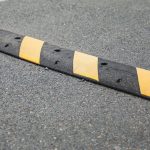Overview
Introduction to speed bumps
Speed bumps are an essential tool in improving road safety. They are designed to slow down vehicles and reduce the risk of accidents in areas where speed limits are often ignored. The introduction of speed bumps aims to create a safer environment for pedestrians, cyclists, and drivers alike. By forcing drivers to reduce their speed, speed bumps help prevent reckless driving and encourage responsible behavior on the road. Additionally, speed bumps can also be used as a traffic calming measure in residential areas, where excessive speeding is a common concern. Overall, the use of speed bumps has proven to be an effective method in enhancing road safety and reducing the number of accidents.
Purpose of speed bumps
The purpose of speed bumps is to slow down vehicles and improve road safety. Speed bumps are often installed in areas with high pedestrian traffic or near schools and residential areas to ensure that drivers reduce their speed. By forcing drivers to slow down, speed bumps help prevent accidents and protect pedestrians from potential harm. Additionally, speed bumps can also help to reduce noise and air pollution caused by excessive speeding. Overall, the installation of speed bumps serves as an effective measure to enhance road safety and create a safer environment for everyone.
Importance of road safety
Road safety is of utmost importance in today’s fast-paced world. With the increasing number of vehicles on the road, it is crucial to implement measures that ensure the safety of all road users. Speed bumps play a significant role in improving road safety by effectively reducing the speed of vehicles. These physical traffic calming devices are strategically placed on roads to slow down drivers, encouraging them to drive at safer speeds. By forcing drivers to slow down, speed bumps help prevent accidents, especially in areas with high pedestrian traffic such as residential areas, school zones, and parking lots. Additionally, speed bumps also promote better adherence to traffic rules and regulations, as drivers are more likely to be cautious and follow speed limits when encountering these obstacles. Overall, the use of speed bumps is an essential tool in enhancing road safety and protecting the lives of both drivers and pedestrians.
Types of Speed Bumps
Traditional speed bumps
Traditional speed bumps are a common feature on roads and are designed to slow down vehicles. They are typically made of asphalt or concrete and have a series of raised sections that force drivers to reduce their speed. These speed bumps are effective in reducing the speed of vehicles, especially in areas with high pedestrian traffic or near schools. However, they can also cause discomfort and inconvenience for drivers, as they can be jarring and cause damage to vehicles if not approached at the right speed. Despite these drawbacks, traditional speed bumps continue to be used as a cost-effective method of improving road safety.
Speed humps
Speed humps, also known as speed bumps, are raised areas on the road that are designed to slow down vehicles. They are typically made of asphalt or concrete and are strategically placed in areas where speeding is a concern, such as residential neighborhoods, school zones, and parking lots. The purpose of speed humps is to reduce vehicle speeds and improve road safety by forcing drivers to slow down. By creating a physical barrier, speed humps encourage drivers to drive at a safer speed, reducing the risk of accidents and injuries. Additionally, speed humps can help to calm traffic and create a more pedestrian-friendly environment. Overall, speed humps play a crucial role in improving road safety and promoting responsible driving behavior.
Speed cushions
Speed cushions are a type of traffic calming measure that are designed to slow down vehicles and improve road safety. Unlike traditional speed bumps, which are typically raised and continuous across the road, speed cushions are smaller and spaced apart. This allows larger vehicles, such as buses and emergency vehicles, to straddle the cushions without experiencing a jarring impact. Speed cushions are often installed in residential areas or near schools to reduce speeding and create a safer environment for pedestrians and cyclists. The use of speed cushions has been shown to effectively reduce vehicle speeds and improve compliance with speed limits, ultimately contributing to a decrease in accidents and injuries on the road.
Benefits of Speed Bumps
Reduced vehicle speed
Reduced vehicle speed is one of the key advantages of speed bump rubber. By forcing drivers to slow down, speed bumps help to create safer road conditions. When vehicles travel at slower speeds, the risk of accidents and collisions is significantly reduced. Additionally, reduced vehicle speed also enhances pedestrian safety, as it allows people to cross the road more safely. Speed bumps serve as a visual reminder for drivers to adhere to the speed limit and promote responsible driving behavior.
Improved pedestrian safety
Speed bumps play a crucial role in improving pedestrian safety. By slowing down vehicles, they create a safer environment for pedestrians and reduce the risk of accidents. The presence of speed bumps encourages drivers to be more cautious and attentive, as they need to navigate the bumps carefully. This increased awareness and reduced speed significantly decrease the chances of collisions with pedestrians. Additionally, speed bumps are particularly effective in areas with high foot traffic, such as residential neighborhoods, school zones, and parking lots. Overall, the use of speed bumps contributes to enhanced pedestrian safety and promotes a culture of responsible driving.
Prevention of accidents
Speed bumps play a crucial role in the prevention of accidents on the road. By strategically placing speed bumps in areas prone to high-speed traffic or areas with a history of accidents, drivers are forced to slow down and adhere to the speed limit. This helps to reduce the risk of collisions and improves overall road safety. Speed bumps serve as a visual and physical reminder for drivers to exercise caution and be aware of their surroundings. Additionally, speed bumps are particularly effective in residential areas and school zones, where the safety of pedestrians and children is of utmost importance. Overall, the use of speed bumps is an effective measure in preventing accidents and promoting safer roads.
Considerations for Speed Bump Installation
Proper placement
Proper placement of speed bumps is crucial to ensure their effectiveness in improving road safety. Speed bumps should be strategically placed in areas where there is a high risk of speeding or accidents, such as near schools, residential areas, and pedestrian crossings. By placing speed bumps in these locations, drivers are forced to slow down, reducing the likelihood of accidents and creating a safer environment for pedestrians and other road users. Additionally, proper placement of speed bumps should take into consideration the visibility and signage to alert drivers of their presence. This helps to ensure that drivers have enough time to react and slow down, further enhancing the effectiveness of speed bumps in promoting road safety.
Design and dimensions
Design and dimensions play a crucial role in the effectiveness of speed bumps. The design of a speed bump determines its ability to slow down vehicles and minimize the risk of accidents. The dimensions of a speed bump, including its height, width, and length, also impact its effectiveness. A well-designed speed bump should have a gradual slope and a rounded shape to ensure a smooth transition for vehicles. Additionally, the dimensions of the speed bump should be appropriate for the road conditions and the desired speed reduction. By considering the design and dimensions of speed bumps, road authorities can implement effective traffic calming measures to enhance road safety.
Accessibility for emergency vehicles
Accessibility for emergency vehicles is a crucial consideration when implementing speed bumps. While speed bumps are effective in reducing speed and improving road safety, they can pose challenges for emergency vehicles. In emergency situations, every second counts, and any delay caused by speed bumps can hinder the response time of emergency vehicles. Therefore, it is essential to design speed bumps that allow for smooth passage of emergency vehicles without compromising the overall effectiveness of the traffic calming measure. This can be achieved by incorporating features such as gradual slopes or gaps in the speed bumps to accommodate the needs of emergency vehicles while still ensuring the desired traffic calming effects.
Challenges and Controversies
Impact on vehicle suspension
Speed bumps have a significant impact on vehicle suspension. When vehicles pass over speed bumps, the sudden change in elevation causes the suspension system to compress and absorb the impact. This can lead to increased wear and tear on the suspension components, such as shocks, struts, and springs. Over time, the repeated stress from traversing speed bumps can result in decreased suspension performance and potentially costly repairs. It is important for drivers to approach speed bumps cautiously and at a reduced speed to minimize the impact on their vehicle’s suspension system.
Noise and vibration
Noise and vibration are important factors to consider when implementing speed bumps. Speed bumps can generate noise and vibrations that can be disruptive to nearby residents and businesses. This can lead to complaints and potential legal issues. Therefore, it is crucial to design and install speed bumps in a way that minimizes noise and vibration. Various measures can be taken, such as using rubber or composite materials that absorb the impact and reduce noise. Additionally, proper maintenance and regular inspections can help identify and address any issues that may contribute to excessive noise and vibration. By addressing these concerns, speed bumps can effectively improve road safety without causing unnecessary disturbances.
Resistance from drivers
Resistance from drivers is a common challenge when it comes to implementing speed bumps. Many drivers argue that speed bumps are inconvenient and can cause damage to their vehicles. They may also claim that speed bumps are unnecessary and only serve to slow down traffic without significantly improving road safety. However, it is important to consider the potential benefits of speed bumps, such as reducing speeding and preventing accidents. By addressing the concerns of drivers and highlighting the positive impact of speed bumps on road safety, it is possible to gain their support and cooperation in implementing these traffic calming measures.
Conclusion
Summary of benefits
Speed bumps are an effective traffic calming measure that can greatly improve road safety. They are designed to slow down vehicles, particularly in areas with high pedestrian activity or near schools and residential areas. The benefits of speed bumps include reducing vehicle speed, preventing accidents, and increasing driver awareness. By forcing drivers to slow down, speed bumps help to create a safer environment for pedestrians and other road users. Additionally, speed bumps can also help to reduce noise pollution and improve air quality by encouraging drivers to use their vehicles more responsibly. Overall, the use of speed bumps has proven to be an effective strategy in improving road safety and promoting responsible driving behavior.
Importance of proper installation
Proper installation of speed bumps is crucial for ensuring their effectiveness in improving road safety. When speed bumps are not installed correctly, they may not serve their purpose of slowing down vehicles and reducing speed. It is important to consider factors such as the appropriate height, width, and placement of speed bumps to ensure they are effective in controlling speed. Additionally, proper signage and markings should be implemented to alert drivers of the presence of speed bumps. Without proper installation, speed bumps may not effectively contribute to road safety and may even pose hazards to drivers and pedestrians.
Future developments in speed bump technology
In recent years, there have been significant advancements in speed bump technology, and further developments are expected in the future. One area of focus is the design of speed bumps that are more effective at reducing vehicle speed while minimizing discomfort for drivers. Researchers are exploring the use of innovative materials and shapes that can better absorb impact and distribute forces, resulting in a smoother ride over the bumps. Additionally, there is ongoing research into the integration of smart technology into speed bumps, such as sensors or cameras that can detect speeding vehicles and alert authorities. These advancements in speed bump technology hold great potential for improving road safety and reducing accidents in the future.








